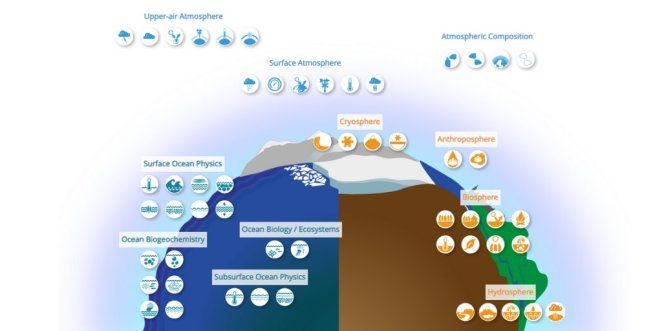
The missing link to net zero
Closing the loop on decarbonized & resilient supply chains with Energy Impact Partners' Nina Litman
In climate tech, reliable information from devices that collect climate data are essential for making evidence-based decisions about planetary warming.
When we imagine climate tech, we often think of innovations that limit emissions and environmental impact. But here, management expert Peter Drucker’s mantra holds true that you can’t manage what you don’t measure. In climate tech, reliable information from devices that collect climate data are essential for making evidence-based decisions about planetary warming. This week, we focus on technologies that monitor Earth’s vital signs.
According to the Global Climate Observing System (GCOS), 54 climate-related variables should be monitored. GCOS, an initiative whose purpose is to ensure that information necessary to address climate issues is collected and disseminated, calls these factors Essential Climate Variables, or ECVs. An ECV is a variable (or a group of linked variables) that contributes to the characterization of Earth’s climate. ECVs can be physical, chemical, or biological.
ECV measurements provide empirical evidence to help understand and predict climate evolution. The data can be used to assess climate risks and to determine causes of climate events. This information can also assist in guiding mitigation and adaptation measures and underpinning climate services.
Given the number of ECVs, it is useful to group them into three domains – land, air, and sea. The graphic below illustrates how these 54 ECVs are divided among the three zones:

The Global Climate Observing System’s 54 essential climate variables (GCOS)
A number of companies offer products and services that collect better, more frequent, and more precise data related to the climate. Sometimes, these efforts supplement collection efforts from public agencies. We describe below, for each domain, one company that has been featured in the news recently.
Terrestrial ECVs include above-ground biomass, river discharge, and snow cover.
Planet Labs can monitor changes in these variables and others using more than 150 satellites. The company collects a dataset of Earth observation imagery and land use changes. (The company’s data collection extends beyond the environment – from photographing the Black Lives Matter street mural in Washington, D.C. to detecting Chinese activity along the Himalayan border with India.)
Planet Labs partnered with the State of California to “develop new satellite technology to monitor climate change.” The company plans to launch a satellite that can detect ‘point source’ climate pollutants, monitor leaks, and identify anomalies at specific locations. These capabilities can help identify polluters and verify compliance with carbon offset agreements.
The company will soon have 21 high-resolution imagers in orbit. These “SkySats” can see any spot on the ground (clouds permitting) at 50 centimeter resolution up to seven times a day. The high resolution and frequent repeat visits permit monitoring of land changes that is more continuous and closer to real-time.
Measurements of air-related ECVs, such as carbon dioxide, methane, and air temperature can, among other things, reveal emission patterns that affect the climate and human health.
Aclima develops Internet-connected air quality sensors as well as software that helps process the results. The company can map pollutants such as carbon dioxide, methane, and particulate matter.
Last week, Aclima released a new data set that it collected and compiled together with Google over a four-year period. Free to the scientific community, the data includes 42 million air quality measurements for California.
ECVs related to the ocean include sea-surface temperature, sea-surface salinity, and surface content.
Saildrone collects measurements of water temperature, salinity, ocean surface current, and other factors. The company obtains ocean data using unmanned surface vehicles (USVs). Saildrone is building a fleet of 1,000 USVs “to cover the planet at a six-by-six-degree resolution – (one saildrone per 360 nautical miles squared).” These collection apparatuses will provide around-the-clock observations of the world’s oceans while “lowering the cost of data acquisition by order of magnitude.”
With COVID-19 causing the postponement of ship and aircraft missions, the National Oceanic and Atmospheric Administration (NOAA) announced that it is accelerating the use of unmanned systems, including some from Saildrone, to collect data.
Saildrone focuses on sea surface metrics. Other companies, like Sofar Ocean, collect sub-surface data.
Technologies like those mentioned will significantly increase the amount of ECV data available. There is a growing hunger for more and better ECV data.
Software advances in areas like machine learning and artificial intelligence can assist in synthesizing enormous datasets and automating their review to yield quick insights, such as where pollution or deforestation is occurring.
For climate information to be actionable, it should be accurate and transparent, and it should adhere to common measures. Standardizing measurements will facilitate coordinating data from multiple sources and enable inter-organization or inter-site comparisons.
One possible vision for the burgeoning demand for ECV monitoring data is that it will be available in an integrated, open-source repository. This giant data pool could be updated with new measurements as they are taken and would benefit from ongoing technical advances that improve granularity, reduce uncertainty, and approach real-time monitoring. Users would access the data to produce comprehensive ECV maps that enhance our understanding of Earth’s climate and how to protect it.
Interested in more content like this? Subscribe to our weekly newsletter on Climate Tech below!

Closing the loop on decarbonized & resilient supply chains with Energy Impact Partners' Nina Litman

The new business of seeing climate from space

How supply chain traceability leads us to Net Zero